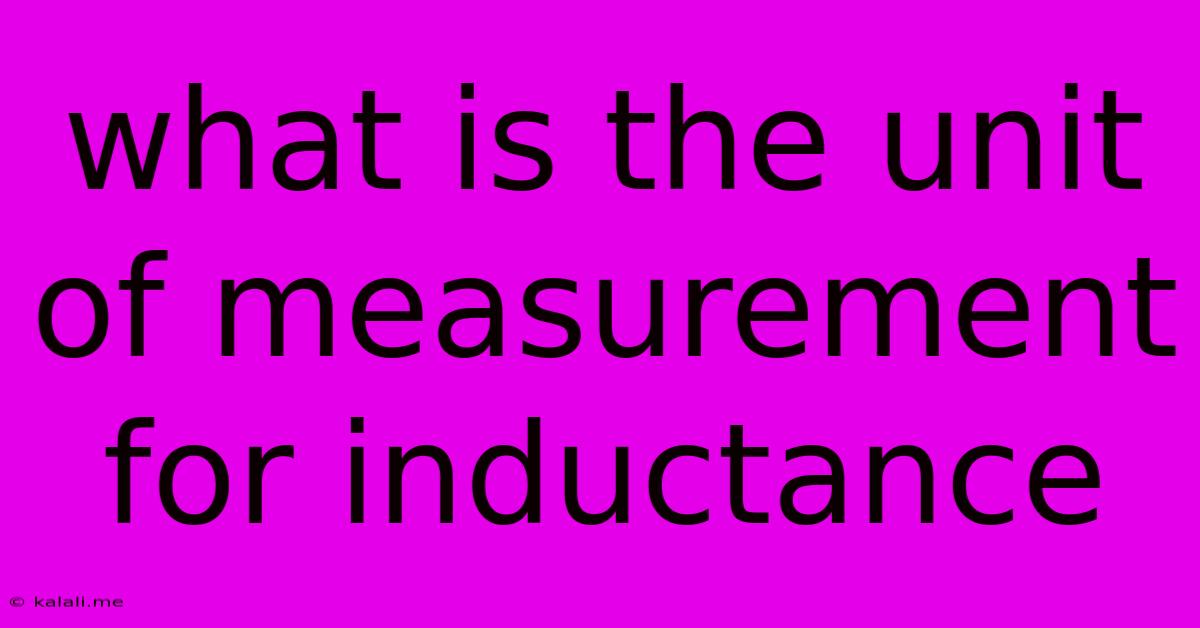What Is The Unit Of Measurement For Inductance
Kalali
Jun 14, 2025 · 3 min read

Table of Contents
What is the Unit of Measurement for Inductance?
Inductance, a fundamental concept in electromagnetism, quantifies a circuit's ability to oppose changes in electric current. Understanding its unit of measurement is crucial for anyone working with electrical circuits and magnetic fields. This article will delve into the unit of inductance, its derivation, and practical applications.
The unit of measurement for inductance is the henry (H), named after Joseph Henry, one of the early pioneers in the study of electromagnetism. One henry is defined as the inductance that will produce an electromotive force (EMF) of one volt when the current through the inductor changes at a rate of one ampere per second. This definition highlights the inherent relationship between inductance, voltage, and the rate of current change.
Understanding the Henry (H)
Let's break down the definition further. The key relationship is expressed by the formula:
V = L * (di/dt)
Where:
- V represents the induced voltage (in volts)
- L represents the inductance (in henries)
- di/dt represents the rate of change of current (in amperes per second)
This formula tells us that a larger inductance (L) will result in a larger induced voltage (V) for the same rate of current change (di/dt). Conversely, a faster rate of current change will produce a larger voltage across an inductor with a given inductance.
Practical Applications and Common Inductance Values
Inductors, components that exhibit inductance, are found in a wide variety of applications, including:
- Filters: Inductors are essential components in electronic filters, helping to separate different frequency signals. These filters are vital in applications ranging from audio systems to power supplies.
- Energy Storage: Inductors can store energy in a magnetic field, making them useful in switching power supplies and resonant circuits. This energy storage capability is crucial for efficient power management.
- Transformers: Transformers utilize the principles of mutual inductance to efficiently step up or step down voltage levels in AC circuits. They are ubiquitous in power distribution systems and electronic devices.
- Sensors: Changes in inductance can be used to sense changes in position, proximity, or other physical quantities. This principle is utilized in various types of sensors.
You'll often encounter inductance values ranging from microhenries (µH, 10⁻⁶ H) in high-frequency circuits to millihenries (mH, 10⁻³ H) in audio applications and even henries (H) in power supply designs. The specific inductance value required depends heavily on the application and the operating frequency.
Beyond the Henry: Understanding Related Concepts
While the henry is the fundamental unit, understanding related concepts is crucial for a complete grasp of inductance:
- Mutual Inductance: This refers to the inductance between two or more coils. It quantifies the ability of one coil's changing magnetic field to induce a voltage in another coil. The unit is also the henry (H).
- Self-Inductance: This refers to the inductance of a single coil. It measures the coil's ability to oppose changes in its own current. The unit is, again, the henry (H).
In conclusion, the henry (H) is the fundamental unit of inductance, a crucial parameter in understanding the behavior of electrical circuits and magnetic fields. Understanding the relationship between inductance, voltage, and current change, as encapsulated in the formula V = L * (di/dt), is vital for anyone working with inductors and electromagnetic phenomena. From microhenries in high-frequency applications to henries in power systems, the henry provides a consistent and standardized measure for this important electrical property.
Latest Posts
Latest Posts
-
What Two Numbers Multiply To 32
Jun 15, 2025
-
Respiratory System Questions And Answers Pdf
Jun 15, 2025
-
Which Of The Following Are Two Classes Of Resistors
Jun 15, 2025
-
A Student Has Successfully Passed 60 Percent
Jun 15, 2025
-
Least Common Multiple Of 6 15 And 9
Jun 15, 2025
Related Post
Thank you for visiting our website which covers about What Is The Unit Of Measurement For Inductance . We hope the information provided has been useful to you. Feel free to contact us if you have any questions or need further assistance. See you next time and don't miss to bookmark.